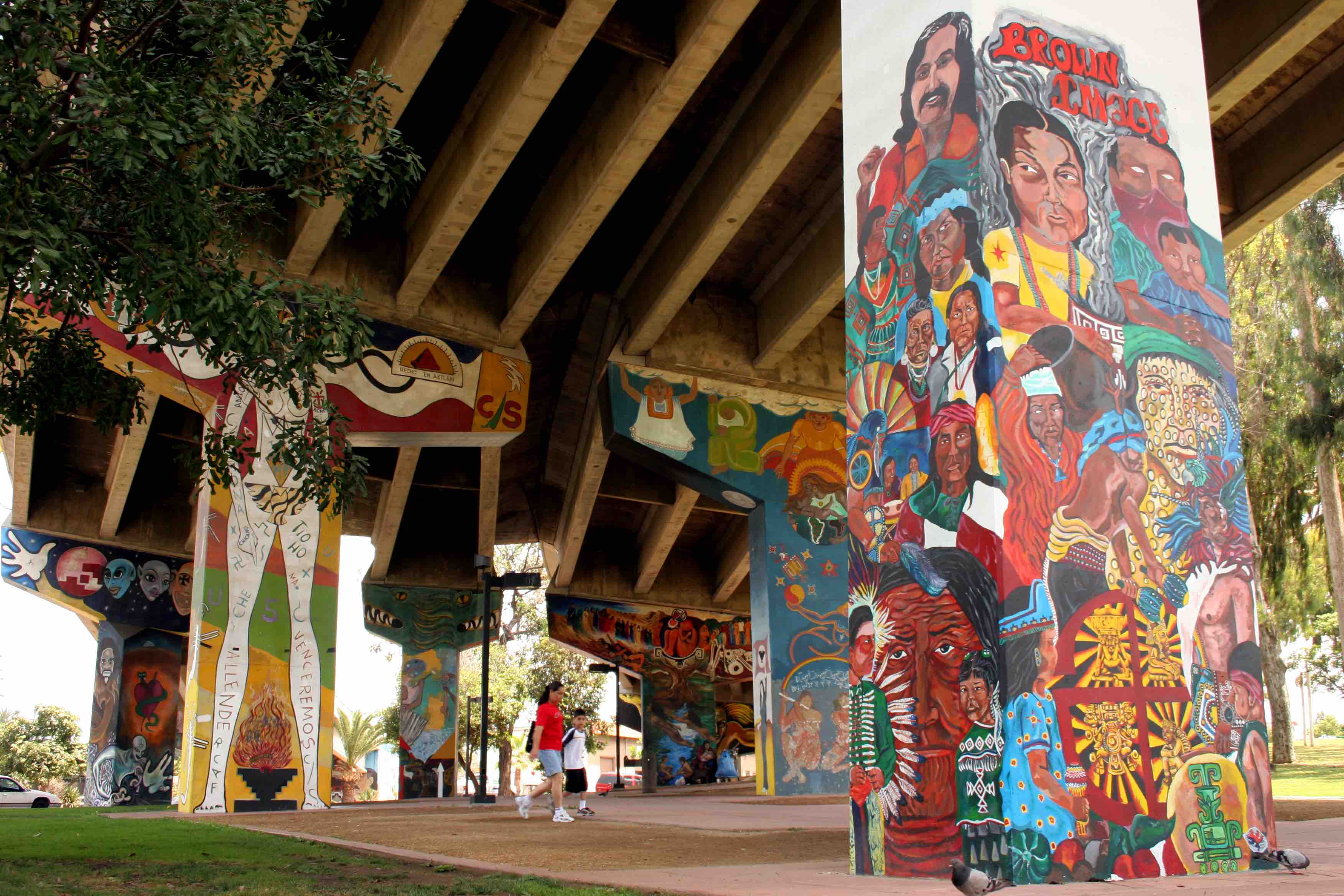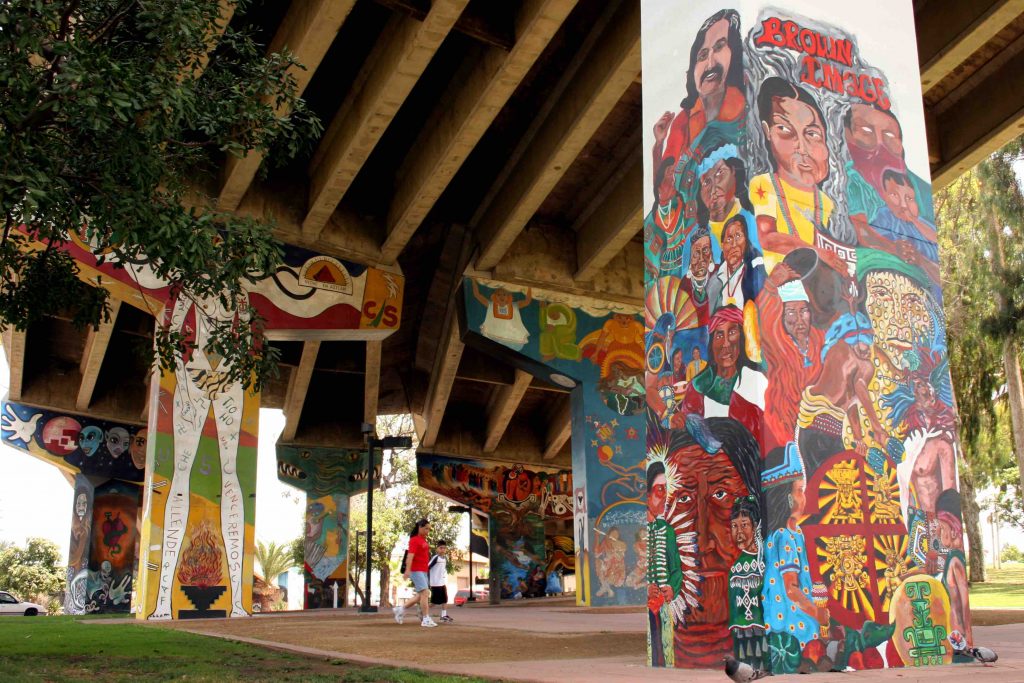For more than four decades, Chicano Park has served as a beacon for San Diego’s Mexican-American community. The site – well known for its murals and for serving as a meeting place for Latino organizing – undoubtedly has local importance. Two years ago, the US government acknowledged the park’s national significance by naming it a National Historic Landmark.
After the construction of the San Diego-Coronado Bridge in 1969, the city planned to make the space beneath a California Highway Patrol substation. But after residents occupied the area for 12 days, it became the 7.4-acre park that holds a special place in history. And in the decades since, the community has transformed the park into a celebration of Chicano and Mexican culture. And murals have played a large role in that.
“Our idea was always to paint this place,” Mario Torero, one of Chicano’s park original muralists, said, according to the San Diego Tribune. “We told the story of the colors and dreams of our ancestors, painting new faces of our sad and glorious history on the pillars and screaming in full rage.”
Since the 1970s, more than 70 murals have cropped up, with artists making commentary on everything from the Mexican Revolution, to the importance of la Virgen in their culture, to the need for arts and books. But as the years went by, some of the murals – most of which live on the pillars that support a five-lane highway – showed signs of damage because of the daily traffic. It took a decade, but starting in 2011, restoration on 20 murals began.
The murals are an important part of San Diego history and the Chicano art movement. Here are the stories of a few of those murals.
1
Cuauhtemoc Aztec Warrior
Felipe Adame created Cuauhtemoc Aztec Warrior in 1978. It was restored in 2012.
2
Los Grandes
With colorful portraits of Frida Kahlo, Diego Rivera, José Clemente, and David Alfaro Siqueiros, Los Grandes pays tribute to Mexican painters. The 1978 mural was designed by Rupert Garcia and renovated in 2012 by Victor Ochoa, Eddie Galindo, Hector Villegas, And Patricia Aguayo.
3
Niños del Mundo
Niños del Mundo came about in 1975 when local muralists invited Charles “Gato” Félix and Norma Montoya to paint something on the Coronado Bridge’s pillars. They chose to create a 3D work of art, which encouraged children to “break repressive chains and pursue happiness by means of books and artists’ brushes,” according to La Prensa. In 2011, Norma repainted the mural.
4
¡Varrio Si. Yonkes No!
Created by Raúl José Jacquez, Alvaro Millan, Victor Ochoa, and Armando Rodríguez in 1977, ¡Varrio Si. Yonkes No! came as response to Barrio Logan’s junkyard controversy. Decades ago, residents put pressure on the government to clear junkyards from their neighborhoods.
However, the slogan has been misinterpreted over the years, with some confusing yonkes for yanquis, aka Yankees. Ochoa told the San Diego Tribune in 2007 that it’s not the only way people have misunderstood the slogan. In the mid-1970s, he passed out fliers that read “Barrio Si, Yonkes No!” (the mural spells barrio with a V to stand for Victory, according to Ochoa). When he attended a meeting at a halfway house, an angry man questioned his flier. “He said, ‘Hey Victor, what do you have against us?'” he told the Tribune. “They thought it meant ‘no junkies.'”
Raúl José Jacquez, Alvaro Millan, Victor Ochoa, Armando Rodríguez, and Vidal Aguirre restored it in 1989.
5
Mujer Cosmica
Created by Esteban Villa, Mujer Cosmica features a woman covered in tattoos – some of which read “familia primero,” “libertad,” “Barrio Logan,” and “Si Se Puede.
A few years ago, the mural was restored, and some of the words in the original version were replaced with others. Check out an earlier version here.
6
La Revolucion Mexicana
Created in 1981, La Revolucion Mexicana depicts an important moment in Mexican history. The mural, which Victor Ochoa painted, uses little color, seemingly to mimic the look of old photography. The top part features different revolutionaries, which showcases how they came from different walks of life. On the base, the words “I Rather Die On My Feet Than Live on My Knees” are written.
7
Geronimo
Geronimo was also created by Victor Ochoa, a Chicano Park “mural maestro.” The full mural shows other parts of Mexican culture, from the mundane to special occasions.
8
Hasta La Bahia/All the Way to the Bay
All the Way to the Bay is a reference to a Ronnie Trujillo-led campaign. The slogan declares that Barrio Logan and Chicano Park should extend all the way to the waterfront.
The Victor Ochoa mural was created in 1978.
9
Chicano Pinto Union
Tony de Vargas created Chicano Pinto Union in 1978. It was restored in 2012 by Mario Chacon, Eddie Galindo and Hector Vargas.
10
Colossus
Inspired by Atlas, Colossus features a figure with outreached hands, supporting the bridge. Created by Mario Torero, Mano Lima, and Laurie Manzano in 1974, the original artists renovated it in 1989.




